#La Tène
Text
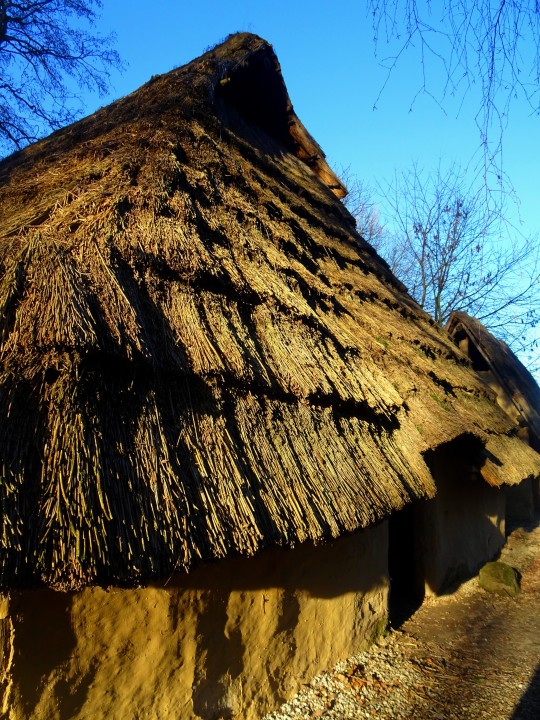
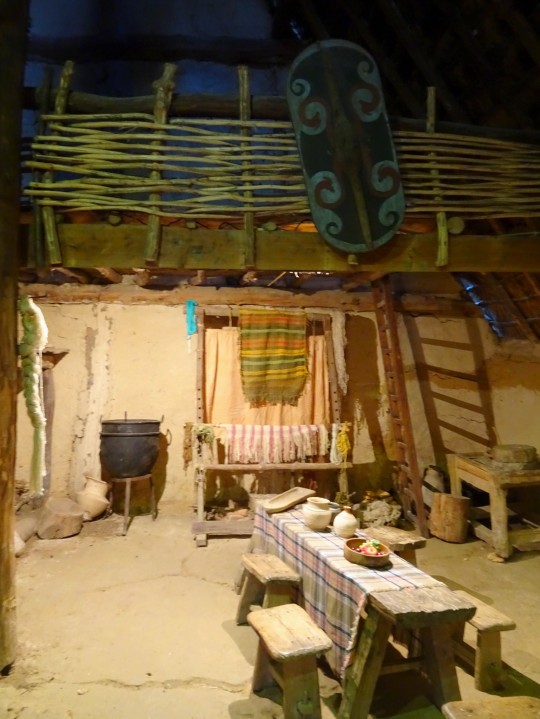



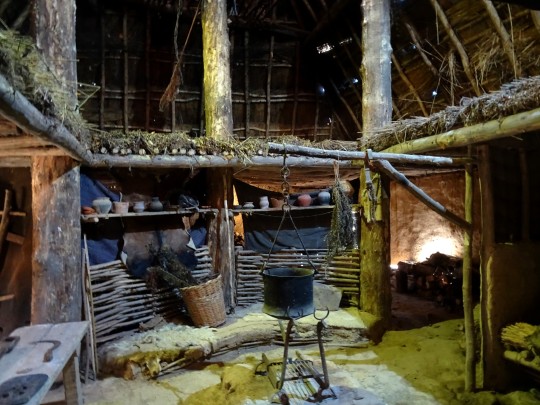

Petite balade en Wallonie, il y a 15 jours, plus précisément l'Archéo-site d'Aubechies. Ici des habitats reconstitués.
les 4 premières : habitat celtique de l'Âge du Fer, culture de la Tène, 100 av. J-C.
les 3 autres : habitat de l'Âge du Fer, culture de Hallstatt, 450 av. J-C.
#belgique#wallonie#aubechies#archéosite#archéologie#préhistoire#celte#celtique#gaulois#la tène#hallstatt#chaumière#chaumes#gaule
3 notes
·
View notes
Text
Ramsl, P. C. (2020) Diversity of male identities in early and middle La Tène period cemeteries in Central Europe. Nitra: Archeologický ústav SAV
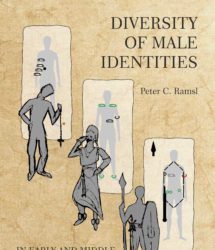
166.p.
"As written in the chapter by J. Gretzinger and St. Schiffels in this book, it is clear by analyzing the DNA that this is a biological man. As mentioned above, it is a special case, proved by two methods. Therefore, it is up to archaeology to provide an interpretation. According to my best knowledge, it is the first proven case of a male person in the early Iron Age who is wearing part of a ‘typical female costume’ – so not only some female marker, but an extraordinary one."
3 notes
·
View notes
Text
La invasión tracocimeria
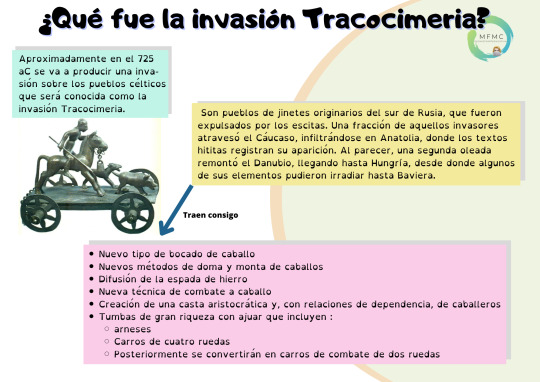
View On WordPress
0 notes
Text
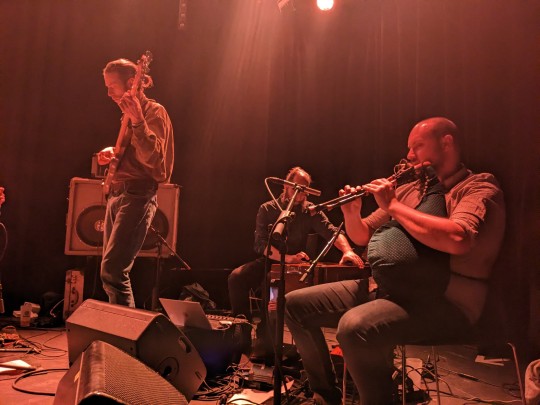

La Tène au Périscope, Lyon.
La transe qui prend si facilement, c'est tellement bon.
1 note
·
View note
Text

Ancient Celtic Helmet Is the Oldest Ever Found in Poland
Unearthed at the Łysa Góra archaeological site, the artifact, some 2,300 years old, is a prime example of Celtic metalworking
Archaeologists in Poland have unearthed a horde of 300 artifacts dating back to the fourth century B.C.E. Found at the Łysa Góra site in the region of Mazovia, near Warsaw, the trove includes iron axes, scissors and, most notably, a rare Celtic helmet.
A team from Warsaw’s State Archaeological Museum and University of Warsaw’s Department of Archaeology has been excavating in Łysa Góra since the spring. According to a statement by the team, the helmet was buried in a charcoal pit, along with four iron axes.
Though it was damaged by age, researchers determined the “spectacular” helmet was originally shaped like a cone, possessing a separate curved neck piece and decorated with etched lines. Its discovery has changed the team’s perceptions of the Celts—a group of Central European tribes who thrived during the Iron Age, from 1200 B.C.E. until 50 C.E.

The helmet is the first artifact of its kind to be found in Poland, as excavation leader Bartłomiej Kaczyński, of the archaeological museum, tells Science in Poland’s Ewelina Krajczyńska-Wujec. Before, only one other, much newer Celtic helmet had been discovered: a first-century piece found in the southern village of Siemiechów. The Łysa Góra helmet is at least 2,300 years old.
“At first we thought it might be some kind of ancient vessel, because bronze vessels are much more common on Polish soil than helmets,” Kaczyński tells Science in Poland, per Newsweek’s Aristos Georgiou. Then, the artifact’s neck piece—an arched plate near its edge—prompted archaeologist Andrzej Maciałowicz to suggest it could be a helmet.
Based on the artifact’s shape, and the fact that its tip was held together by a double knob, researchers concluded the piece is an early La Tène helmet. The Celtic culture of La Tène—French for “the shallows”—is named for Lake Neuchâtel in Switzerland, where researchers first found La Tène objects in the late-1800s, per ARTnews’ George Nelson. The culture formed around the fifth century B.C.E., about when Celts came into contact with Etruscan and Greek people from south of the Swiss Alps.
The La Tène style of metalworking developed between the fourth and third centuries B.C.E., and examples of it are “very rare,” per Science in Poland. While 1970s and ‘80s excavations at Łysa Góra revealed some small La Tène artifacts, researchers assumed they ended up in Poland via trading.
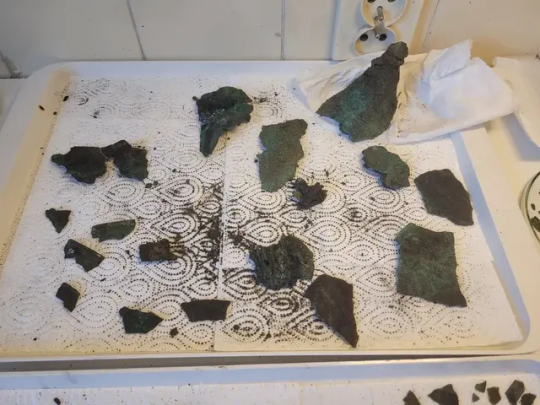


The recently discovered helmet, on the other hand, is an example of “the most advanced Celtic metallurgy,” Kaczyński says, and the piece was seemingly owned by a Celt, per Newsweek. The La Tène helmet’s presence in northern Poland changes researchers’ perceptions of the reach of the Celtic world in the pre-Roman period.
The other artifacts the research team found illustrate the ancient Celts’ proclivity for animal husbandry and farming: Blades from shears might have been used to cut sheeps’ wool, and scythes might have cut grain or grass. According to a statement by the archaeological museum, the researchers also found a collection of glass, amber and stone artifacts, including jewelry—bracelets, ornate necklaces and rings.
The helmet was taken to the State Archaeological Museum’s conservation department, where an expert in iron and bronze artifacts will spend several months conserving its pieces. As Kaczyński tells Science in Poland, the research team began excavating Łysa Góra to help construct an educational trail through the site. But the team’s “multitude of discoveries” indicates they may have more archaeological work to do than they thought.
By Sonja Anderson.

#Ancient Celtic Helmet Is the Oldest Ever Found in Poland#Łysa Góra archaeological site#war helmet#La Tène helmet#ancient artifacts#archeology#archeolgst#history#history news#ancient history#ancient culture#ancient civilizations#iron age#celtic history
43 notes
·
View notes
Text

La Tène style design by Aleck Fagan
#La Tène style#pagan#witch#nature#design#pagan witch#the goddess#the horned god#moon#sun#celtic polytheism#celtic witch#celtic style#celtic paganism#celtic art#celtic#irish art#irish heritage#irish history#ancient ireland#concentric#iconography#druidism#pagan druid#druid#sigils
3 notes
·
View notes
Text
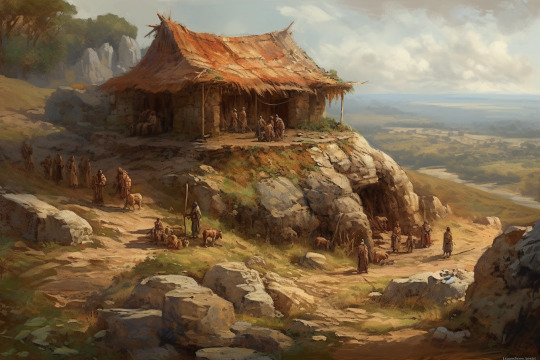


I directed Midjourney to make pictures of the the Yamnaya Culture (first image) and the La Tène Culture (second and third) with a good deal of fantastic latitude. Those cows … wow.
by Midjourney v5
3 notes
·
View notes
Photo
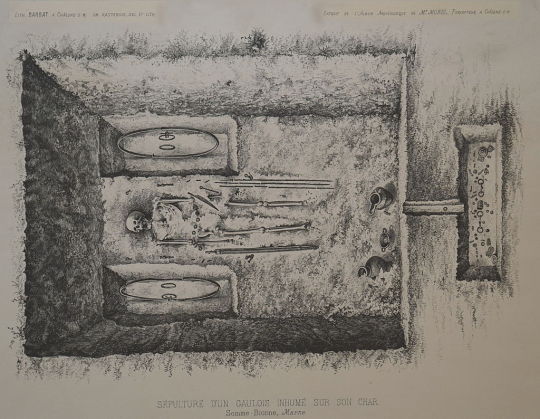

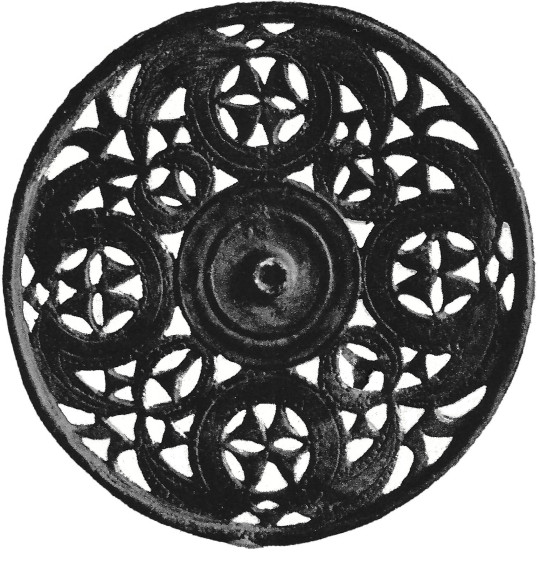

Somme Bionne, early La Tene male chariot burial
my personal favourite - fragment of horse gear with swirling swastikas
#archaeology#swastika#iron age#chariot burial#prehistory#celts#horse gear#funerary rites#prehistoric europe#La Tène period#princely tomb#artefact#my upl
5 notes
·
View notes
Text
My latest tattoo work:
Triskelion with La Tène Celtic ornamentation and a fine knotwork band. A devotional piece for three beloved gods. A joy to work on this piece - thank you for trusting me and for traveling all the way out to California to be tattooed. 🖤
Made at Ritual Tattoo in Berkeley.
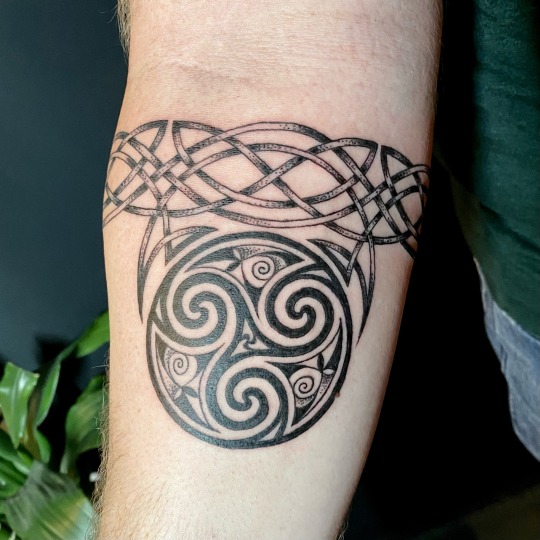
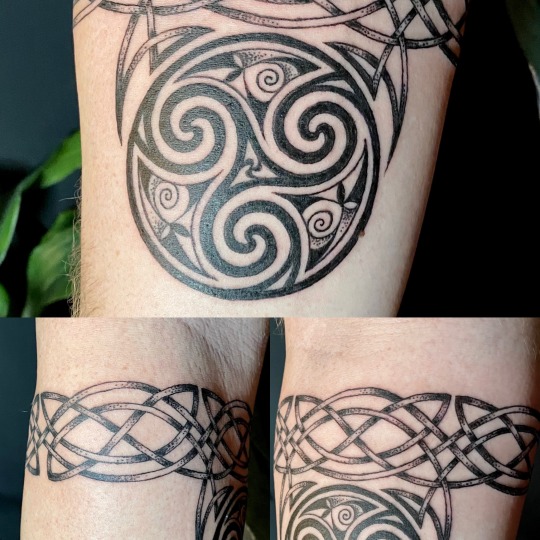
1 note
·
View note
Text






A Celtic Anthropomorphic Hilted Short Sword/Dagger and Scabbard, 1st cent. B.C.
Based mostly on two local examples (one found in 1900 in Mirebeau-sur-Bèze, and the other in the river Saône, at the ford called "Iles Percées" in 1974, and both kept in the @museedenon in Chalon-sur-Saône) as well as others.
The blade is high carbon steel with a hollow ground diamond section, and has been slack-quenched so that only the edges would harden. A sun, crescent moon and two silver lines were inlaid on one face.
The hilt is bronze, cast in 4 parts. The shape of it recall the "proper" anthropomorphic hilts of the earlier phases in a simplified form, but it's not hard to identify the legs, body, arms and head.
The scabbard is bronze, and as should be can be taken down relatively easily. The front plate overlaps the back plate on the sides, and the throat piece and chape also keep holding these two together.
I have a boundless admiration for the Celtic smiths of old.
There is both much to say about these swords - questions, mostly, and not much in terms of answers.
Such swords appear all over Europe, and a striking feature in addition to the hilt is these inlays of a moon and a sun - though some swords only show a single central strip of gold.
Maybe my current reads on metal finishes has me overthink on the meaning of these inlays - or rather, the fact that they did have a meaning, now lost to us.
But it made sense to me that the blade could have been heat-blued, to emphasise the moon and sun at twilight - the silver lines could then be the Milky Way or the Divide between Night and Day, maybe at the time of the Equinox.
Bluing of blades is also found later on inlaid Mediaeval swords, with a possibility of a continuity of this technique. I'd say more, but space here is limited.
I don't know.
Not to mention the strong symbolism of the scabbard (you do know the Latin word for scabbard, right ?) associated with the blade dangling between the hilt's "legs".
Ritual blade fitting with fertility/astronomy/renewal of the cycle ?
Damn you, Celts and Gauls, who made such marvels and didn't write down a thing, and now all is lost in the sea of Time and Silence.
All that we can affirm is the undeniable highly symbolic meaning of such artifacts - as the Archaeologist in me would say.
Many thanks to Dr Guillaume Reich - leading expert on La Tène weapons - for the advice, insight and bibliography.
142 notes
·
View notes
Text
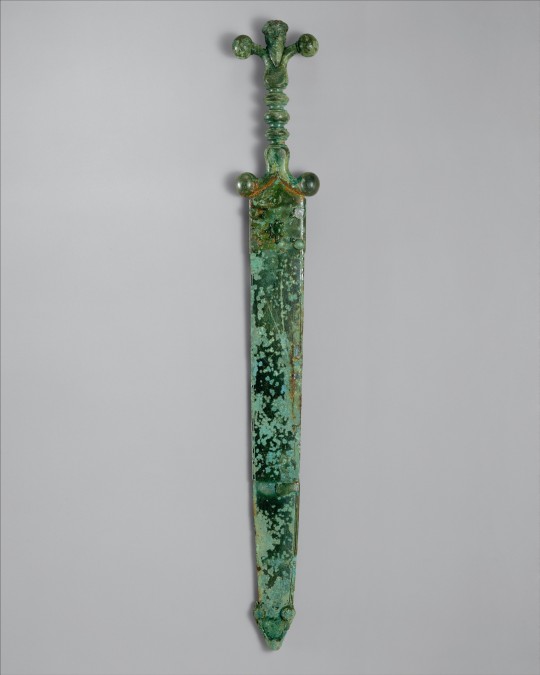
Sword and Scabbard
Celtic, ca. 60 BCE
Although the scabbard has become amalgamated to the iron blade, affecting parts of the surface, its ornamentation and the exquisitely worked hilt make the whole an evocative statement about the technical ability of the Celts, the powerful conquerors of ancient Europe. The sword is of a type associated with the La Tène culture, named after the important Celtic site on Lake Neuchâtel in present-day Switzerland and eastern France. Other related anthropomorphic swords from diverse finds in France, Ireland, and the British Isles demonstrate the expansion of the Celts across Europe.
343 notes
·
View notes
Text
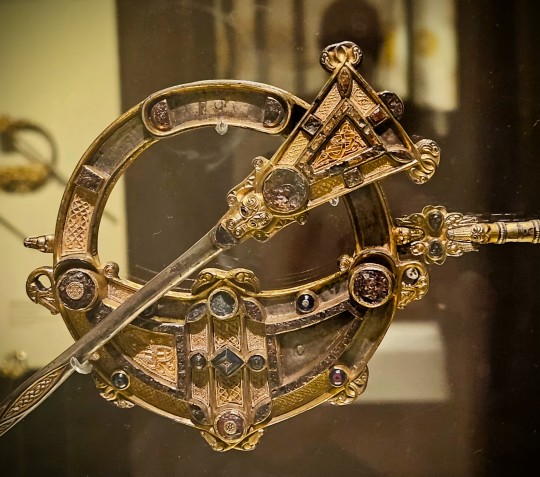
The Tara Brooch/ Dealg na Teambrach C8th CE, found in County Meath 1850
It is made of cast and gilt silver and is elaborately decorated on both faces. The front is ornamented with a series of exceptionally fine gold filigree panels depicting animal and abstract motifs that are separated by studs of glass, enamel and amber. The back is flatter than the front, and the decoration is cast. The motifs consist of scrolls and triple spirals and recall La Tène decoration of the Iron Age.
A silver chain made of plaited wire is attached to the brooch by means of a swivel attachment. This feature is formed of animal heads framing two tiny cast glass human heads.
Along with such treasures as the Ardagh Chalice and the Derrynaflan Paten, the Tara Brooch can be considered to represent the pinnacle of early medieval Irish metalworkers’ achievement. Each individual element of decoration is executed perfectly and the range of technique represented on such a small object is astounding.
text: National Museum of Ireland
(2023)
158 notes
·
View notes
Text
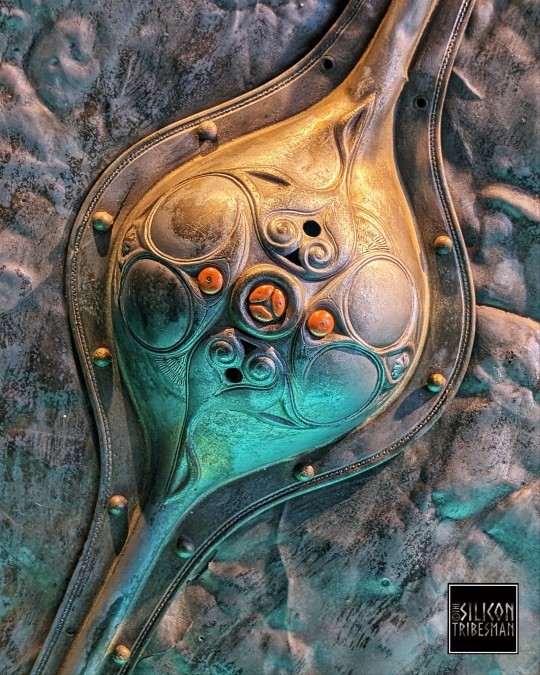
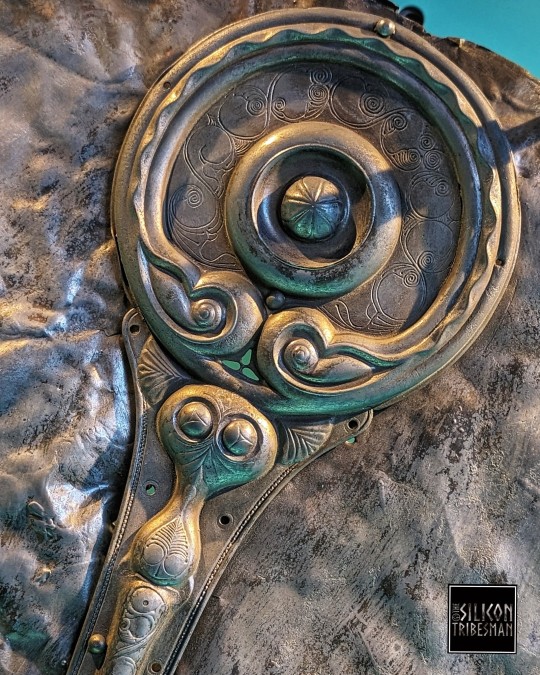
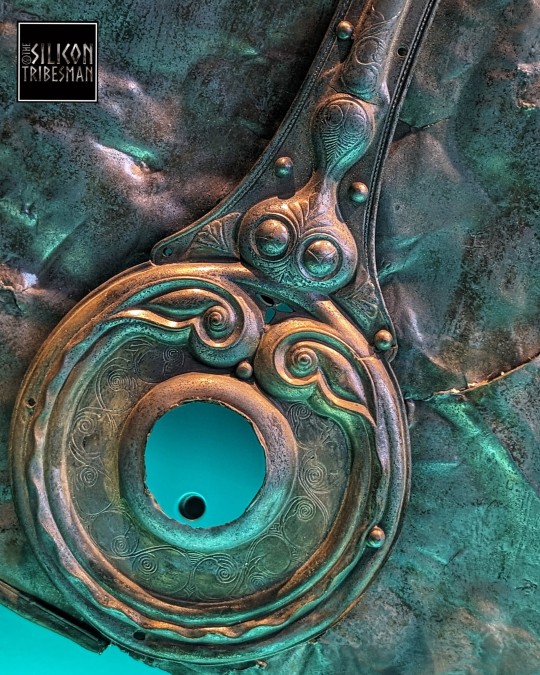
La Tène Styled Detailing from the Iron Age Witham Shield (Replica), The Collection, Lincoln
#ice age#stone age#bronze age#iron age#copper age#prehistoric#prehistory#neolithic#mesolithic#paleolithic#chalcolithic#metalwork#metalworking#shield#weapon#weaponry#ancient history#ancient cultures#ancient craft#ancient design#Lincoln
66 notes
·
View notes
Note
I'm doing a College class on Ancient Foods. My focus is on Honey like the different recipes and usages in Medieval era. I found like a couple recipes, a thing on religious relation ("Milk and Honey of Paradise") /Crusades, medicinal use, and possibly bees/beeswax because I was struggling to get something.
Y'all have any recommendations?
(I've brought Zoe in on this one; the following is a collaborative effort. Also I'm assuming you have access to your university library so you can get ahold of the cited material below quickly and for free.)
Can you include beverages? Honey is the main ingredient in mead, which should give you a lot to talk about. Susan Verberg is the premier researcher on medieval mead, and has some excellent works on both mead making and honey production. She has a website at https://medievalmeadandbeer.wordpress.com/ where you can find both her formal publications and her blog.
If you do want to talk about beverages, there were other medieval drinks that used honey. Some citations for you:
Breeze, Andrew. “What Was ‘Welsh Ale' in Anglo-Saxon England?” Neophilologus, vol. 88, no. 2, 2004, pp. 299–301.
Fell, Christine E. “Old English ‘Beor’." Leeds Studies in English, vol. 8, 1975, pp. 76-95.
You can also go into cultural symbolism; here are a couple on that:
Enright, Michael J. Lady with a Mead Cup: Ritual, Prophecy, and Lordship in the European Warband from La Tène to the Viking Age. Four Courts Press, 2013.
Rowland, Jenny. “OE Ealuscerwen/Meoduscerwen and the Concept of ‘Paying for Mead'." Leeds Studies in English, vol. 21, 1990, pp. 1-12.
Also you might want to look into the general concept of the "mead of poetry" from the Old Norse sources. You can find the origin story for that in the Prose Edda, I believe.
Definitely check out https://www.foodtimeline.org for recipes with honey during the period - they have more than you'd expect. There's also a few medieval cookbooks you can parse through. Here's an online one you can sort through that does a great job modernizing the translations: https://www.medievalcookery.com/etexts.html
As for honey itself -- there's actually quite a bit of research on that! Honey was quite a specialized trade, and most of the medieval world used it for sweetener, so there's a good amount of research.
A few leads:
honey as an alternative to sugar, which was expensive, imported, and could indicate class
honey grading: honey was graded based on location/provenance, type (lavender, orange blossom, etc.), and also by grade. However, their method of grading was very different to our modern one.
honey as a preservative, not just for flavor
Articles on this subject:
(DEFINITELY this one!!) Fava, Lluis Sales, et al. “Beekeeping in Late Medieval Europe: A Survey of Its Ecological Settings and Social Impacts.” Anales de La Universidad de Alicante. Historia Medieval, no. 22, 2021, pp. 275-96, https://doi.org/10.14198/medieval.19671.
Wallace-Hare, David, editor. New Approaches to the Archaeology of Beekeeping. Archaeopress, 2022. JSTOR, https://doi.org/10.2307/j.ctv2b07txd.
Verberg, Susan. “Of Hony: A Collection of Mediaeval Brewing Recipes for Mead, Metheglin, Braggot, Hippocras &c. — Including how to Process Honey — from the 1600s and Earlier,” 2017. Academia.edu.
If you want to look more into the medicinal usage, Cockayne's Leechdoms, Wortcunning, & Starcraft collects all the medical & scientific texts of the Old English period. It's old enough to be public domain, so it's available on the Internet Archive and HathiTrust in searchable form, meaning you can just ctrl-F "honey" and see what comes up.
Let us know how it goes!
70 notes
·
View notes
Note
I need to evacuate a suspicious amount of 'Celtic' La Tène Type II's to your location, don't ask just take them, I need to run!
I have no idea what those are- Sounds vague enough for me to have plausible deniability though, so okay-
18 notes
·
View notes
Text
'A cusciénza
" Vurria sapé’ ched’è chésta cusciénza
ca spisso aggio sentuto ’e nnummenà’;
stóngo speruto ‘e fa’ la conoscenza.
Spiecàteme che vvo' significà’.
Aggio spiato a nu maésto 'e scòla
ca tène scòla all'università.
M'ha ditto: “Figlio mio, questa parola
si usava si, ma tantu tiémpo fa.
Ora la coscienza si è disintegrata
pochi sóngo rimasti ‘e chilli llà
ca a ‘sta paròla réstano attaccate
campanno con onóre e dignità.
Mo c'è l'assegno a vuoto, il peculato,
‘a cambialètta e chésti ccòse ccà;
mariuóle ce ne stanno a tunnellate
'e tutt’e spècie, ‘e tutt‘e qqualità.
'O piccirillo, 'o gruósso, 'o gigantésco,
chille ca sanno cómm'hann'a arrubbà;
e chi 'i denunzia a chiste, chi s’ammésca,
so piézze gruósse, nè chi t'ô ffa fà'.
Mo ll'uóglio ô ffanno c’ô ssapone 'e piazza
‘o burro ‘mmócca te fa’ vummecà’
‘a pasta, ‘o ppane, ‘a carne, cos'e pazze:
si è aumentata la mortalità.
‘E mmedicine po che t’hanno fatto
t’hanno ‘mbriacato pure chélli là:
si sulo nu sciruppo mo t’accatte,
ringrazia a Ddio si siéguite a campà’.
E che vve pòzzo dì' 'e cèrti ffamiglie
ca a pèlle ‘ncuóllo fanno accapunà:
marito, móglie, mamma, sòra, figlie,
famme stà' zitto, nun me fa’ parlà’.
Perciò - m'ha ritto stu maésto 'e scòla -
sta conoscènza tu pecché ‘a vuo' fa’?
Nisciuno ‘a iusa chiù chésta paròla;
mò viéne tu e a’ vuo’ ripristinà’.
Insómma tu vuò i’ cóntro corrènte ,
ma 'sta penzata chi t'â fatta fà’:
‘a gènte 'e mo sulo accussi è cuntènta,
sènza cusciénza pò tirà’ a campà’.”
Antonio de Curtis
14 notes
·
View notes